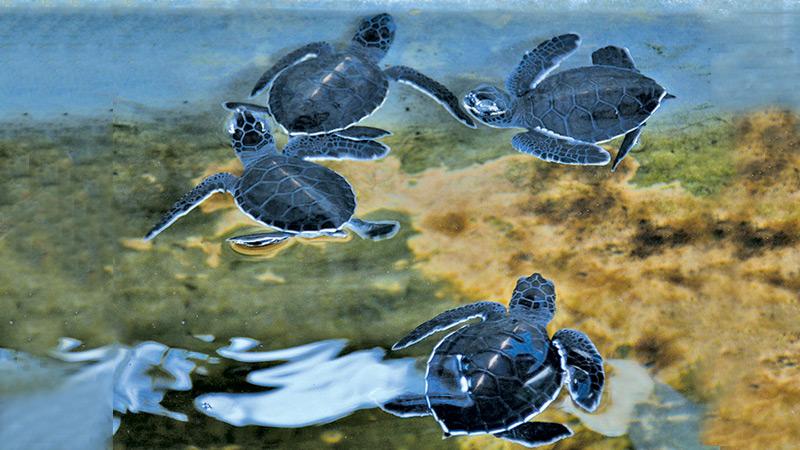
Nuwan Priyashantha Kannangara has to pay for the maintenance of his family’s turtle hatchery in Kaikawala, Induruwa, out of his pocket with no local or foreign tourists visiting the hatchery on Tuesday and less than 15 by Wednesday evening.
 The Induruwa Sea Turtle Conservation Kannangara’s family runs, sees up to 30 tourists daily during Sri Lanka’s off season and up to 70 tourists per day during the season. However, following the Easter Sunday attacks that left 259 dead including over 40 foreigners, targeted hotels and churches, tourist arrivals into the country drastically dipped. Now Kannangara barely sees 20 tourists a day in the hatchery that charges Rs. 50 from local adults and Rs. 300 from foreigners as an entry fee.
The Induruwa Sea Turtle Conservation Kannangara’s family runs, sees up to 30 tourists daily during Sri Lanka’s off season and up to 70 tourists per day during the season. However, following the Easter Sunday attacks that left 259 dead including over 40 foreigners, targeted hotels and churches, tourist arrivals into the country drastically dipped. Now Kannangara barely sees 20 tourists a day in the hatchery that charges Rs. 50 from local adults and Rs. 300 from foreigners as an entry fee.
According to recent statistics by the Sri Lanka Tourism Development Board, August 2019 recorded 143,587 arrivals, an increase from 115,701 the month before. Compared to August last year the tourism industry is suffering a decrease of 28.1 per cent that recorded 200,359 arrivals.
India remains the largest tourist generator to Sri Lanka (accounting for 26 per cent), followed by the United Kingdom (ten per cent), China (seven per cent) and Germany and France (both five per cent).
“But most of these tourists who have started to gradually come into the country are not high paying tourists,” Kannangara lamented.
His other concern is that tourists, especially from China, do not take interest in animal conservation projects such as turtle hatcheries.
There are 10 turtle conservation projects in the island, all based in Southern Sri Lanka.

Kannangara said maintaining a hatchery comes with lofty expenses. They have to buy about 15 kilos of fish at a cost of Rs. 400 per kilo daily to feed the turtles. They also have to hire a labourer at Rs. 1,500 per day at least two times a week to clean the tanks. When the turtles lay eggs they buy an egg at Rs. 20 from the villagers.
“That is what we do. These villagers sell the eggs for food, but what we do is buy them at the same price and conserve them,” Kannangara explained.
Some days they buy 500 to 600 eggs. To make matters worse, some villagers charge up to Rs. 40 per egg.
“After the Easter attacks we were badly hit. We run this hatchery with passion but now we can’t run it with the cash we earn from tourists. We have to use money from other sources to maintain it,” Kannangara said.
 The hatchery is not the only institution that was affected by the April 21 terrorist attacks. Government sources said 80 per cent of hotel bookings were cancelled as the aftermath of the incident. Soon after the attacks tourists arrivals slipped by 70.8 per cent in May to 37, 802 and in June by 57.0 per cent to 63, 072 as the government and the private sector took immediate recovery measures such as slashing hotel charges along with airline fees.
The hatchery is not the only institution that was affected by the April 21 terrorist attacks. Government sources said 80 per cent of hotel bookings were cancelled as the aftermath of the incident. Soon after the attacks tourists arrivals slipped by 70.8 per cent in May to 37, 802 and in June by 57.0 per cent to 63, 072 as the government and the private sector took immediate recovery measures such as slashing hotel charges along with airline fees.
 Though the tourist numbers are seeing a gradual increase, it is yet to reflect in tourist expenditure. This is because the current tourists are drawn to the decreased prices and attractive packages offered.
Though the tourist numbers are seeing a gradual increase, it is yet to reflect in tourist expenditure. This is because the current tourists are drawn to the decreased prices and attractive packages offered.
National Tourist Guide/Lecturer Ruwan de Silva said destinations such as Bentota and Beruwala where he operate from, still have an occupancy of 15 to 20 per cent only.
Analysing the hotel bookings made thus far following the Easter Sunday attacks, Roshi Stronach a member of Sri Lanka Association of Inbound Tour Operators (SLAITO) and Director Sales and Marketing at Lion Royal Resorts said the European market is still sluggish in generating tourists to Sri Lanka.
“They are the high spending tourists. Prior to the terrorist attacks the European market was gradually increasing but dropped drastically after the attacks and are yet to improve despite the marketing or recovery mechanisms the country adopted,” she said.
She also said that this dip is naturally seen in terrorism hit tourist destinations.
However, Sri Lanka is expecting 2.1 million tourist arrivals by the end of this year. The expected tourist arrival figure for 2019 (before the Easter Attacks) was 2.5 million.
Tourism Development Minister John Amaratunga said the bouncing back from the attacks is “unprecedentedly passing” the anticipated recovery process.
“The Borah Convention attracted 23,000 individuals. They are expected to travel around the country after their convention ends on Monday September 9,” Minister Amaratunga said.
He added that with the Asian Travel Agency Association expecting to meet in Sri Lanka and the upcoming World Surf League (WSL) scheduled to be held in Arugam Bay, the tourist industry will recover significantly.
“These events will be held at the end of this month and are positives for tourism. The WSL will draw tourists from about 40 countries,” he said.
Pix Sarath Peiris
